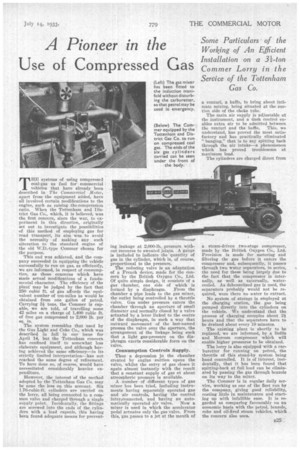A Pioneer in the Use of Compressed Gas
Page 39

If you've noticed an error in this article please click here to report it so we can fix it.
Some Particulars of the Working of An Efficient Installation on a 3i-ton Commer Lorry in the Service of the Tottenham Gas Co.
THE systems of using compressed coal-gas as fuel for commercial vehicles that have already • been described in The Commercial Motor, apart from the equipment added, have all involved certain modifications to the engine, such as raising the compression ratio. When the Tottenham and District Gas Co:, which, it is believed, was the first concern, since the war, to experiment in this direction, originally set out to investigate the possibilities of this method of employing gas for road transport, its aim was to avoid the necessity of making any such alteration to the standard engine of the old W.D.-type Oommer chosen for the purpose.
This end was achieved, and the company succeeded in equipping the vehicle successfully to run on gas, as efficiently, we are informed, in respect of consumption, as those concerns which have Made actual modifications of a fundamental character: The efficiency of the plant may be judged by the fact that 250 cubic ft. of gas affords the equivalent number of ton-miles as would be obtained from one gallon of petrol. Carrying 3i. tons, the Commer is capable, we are told, of travelling some 42 miles on a charge of 1,400 cubic ft. of free gas compressed to 2,000 lb. per sq. in.
The system resembles that used by the Gas Light and Coke Co., which was described in full in our issue for April 14, but the Tottenham concern has confined itself to somewhat less elaborate equipment, and although having achieved the same efficiency—in its strictly limited interpretation—has not reached the same degree of refinement. To have done so, of course, would have necessitated considerably heavier expenditure.
llowever, the interest, of the method adopted by the Tottenham Gas Co. may be none the less on this account. Six 1.76-cubic-ft. cylindersare carried on the lorry, all being connected to a common valve and charged through a single supply point. Incidentally, the fittings are screwed into the ends of the cylinders with a lead capsule, this having beeia found adequate means for prevent
ing leakage at 2,000-lb. pressure with-, out recourse to sweated joints. A gauge is included to indicate the' quantity of gas in the cylinder, which is, of course, proportional to the pressure.
The reducing valve is an adaptation of a French device, made for the concern by the British Oxygen Co., Ltd. Of quite simple design, it consists of a gas chamber, one side of which is formed by a diaphragm. From the chamber a pipe leads to the gas mixer, the outlet being controlled by a throttle valve. Gas under pressure enters the chamber through an aperture of small diameter and normally closed by a valve actuated by a lever linked to the centre of the diaphragm, in such a way that outward movement of the last-named presses the valve over the aperture, the arrangement of the linkage being such that a light gas-pressure on the diaphragm exerts considerable force on the valve.
Consumption Controls Supply.
Thus a depression in the chamber created by engine suCtion opens the valve, whilst the entry of gas closes it again almost instantly With the result that a constant supply of gas at about atmospheric pressure is available.
A number of different types of gas mixer has been tried, including instruments having separately operated gas and air controls, having the control inter,,conneeted, and having an automatically operated air valve. Now a mixer is used in which the accelerator pedal actuates only the gas Valve. From this, gas passes to a jet at the mouth of venturi, a baffle, to bring about intimate mixing, being situated at the suction side of the choke tube.
The main air supply is adjustable at the instrument, and a dash control enables extra air to be admitted between the venturi and the baffle. This, we understand, has proved the most satisfactory and has practically eliminated " banging," that is to say spitting back through the air intake—a phenomenon which has proved troublesome at maximum loan.
The cylinders are charged direct from a steam-driven two-stage compressor, made by the British Oxygen Co., Ltd. Provision is made for metering and filtering the gas before it enters the compressor and, subsequently, it passes through two water separators, in series, the need for these being largely due to the fact that the compressor is internally, as well as externally, watercooled. As debenzolized gas is used, the separators probably would not be required, were there DO water to extract.
No system of storage is employed at the charging station, the gas being pumped directly into the cylinders on the vehicle. We understand that the process of charging occupies about 2-i hours and that the separators have to be drained about every 10 minutes.
The existing plant is shortly to be replaced, we are informed, by .a Bellis and Morcom compressor which will enable higher pressures to be obtained.
The lorry is also equipped with a carburetter for running on petrol, the throttle of this stand-by system being hand controlled. It is of interest, incidentally, that it has been found that spitting-back at full load can be eliminated by passing the gas through benzoic on its way to the mixer.
The Commer is in regular daily service, working as one of the fleet run by the company, giving good reliability, costing little in maintenance and starting up with infallible ease. It is regarded as comparing favourably on an economic basis with the petrol, benzole, coke and oil-fired steam vehicles, which the concern also uses.




























































































